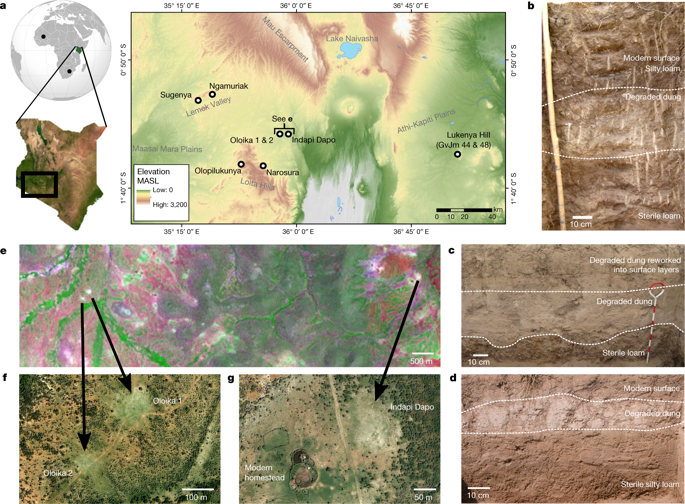Our official English website, www.x-mol.net, welcomes your feedback! (Note: you will need to create a separate account there.)
Ancient herders enriched and restructured African grasslands
Nature ( IF 64.8 ) Pub Date : 2018-08-29 , DOI: 10.1038/s41586-018-0456-9 Fiona Marshall , Rachel E. B. Reid , Steven Goldstein , Michael Storozum , Andrew Wreschnig , Lorraine Hu , Purity Kiura , Ruth Shahack-Gross , Stanley H. Ambrose
Nature ( IF 64.8 ) Pub Date : 2018-08-29 , DOI: 10.1038/s41586-018-0456-9 Fiona Marshall , Rachel E. B. Reid , Steven Goldstein , Michael Storozum , Andrew Wreschnig , Lorraine Hu , Purity Kiura , Ruth Shahack-Gross , Stanley H. Ambrose

|
Grasslands are one of the world’s most extensive terrestrial biomes and are central to the survival of herders, their livestock and diverse communities of large wild mammals1–3. In Africa, tropical soils are predominantly nutrient-limited4–6 but productive grassy patches in wooded grassland savannah ecosystems2,4 grow on fertile soils created by geologic and edaphic factors, megafauna, fire and termites4–6. Mobile pastoralists also create soil-fertility hotspots by penning their herds at night, which concentrates excrement—and thus nutrients—from grazing of the surrounding savannahs7–11. Historical anthropogenic hotspots produce high-quality forage, attract wildlife and increase spatial heterogeneity in African savannahs4,12–15. Archaeological research suggests this effect extends back at least 1,000 years16–19 but little is known about nutrient persistence at millennial scales. Here we use chemical, isotopic and sedimentary analyses to show high nutrient and 15N enrichment in on-site degraded dung deposits relative to off-site soils at five Pastoral Neolithic20 sites (radiocarbon dated to between 3,700 and 1,550 calibrated years before present (cal. bp)). This study demonstrates the longevity of nutrient hotspots and the long-term legacy of ancient herders, whose settlements enriched and diversified African savannah landscapes over three millennia.Isotopic and sedimentary analyses of soils at Pastoral Neolithic archaeological sites in Kenya demonstrate the long-term influence of nutrient enrichment on savannah environments that has accompanied pastoralist settlement over the past three millennia.
中文翻译:

古代牧民丰富改造非洲草原
草原是世界上最广泛的陆地生物群落之一,是牧民、牲畜和大型野生哺乳动物多样化群落生存的核心1-3。在非洲,热带土壤主要是营养有限的 4-6,但在树木繁茂的草原热带草原生态系统 2,4 中,多产的草丛生长在由地质和土壤因素、巨型动物群、火和白蚁 4-6 形成的肥沃土壤上。流动牧民还通过在夜间圈养他们的牛群来创造土壤肥力热点,这会集中来自周围大草原放牧的排泄物,从而集中养分 7-11。历史上的人为热点生产优质草料,吸引野生动物并增加非洲大草原的空间异质性 4,12-15。考古研究表明这种效应至少可以追溯到 1, 000 年 16-19 但对千禧年尺度的营养持久性知之甚少。在这里,我们使用化学、同位素和沉积分析来显示相对于五个新石器时代牧区 20 个地点的异地土壤(放射性碳在现在之前的 3,700 和 1,550 校准年之间(校准 bp),现场退化的粪便沉积物中的高营养物质和 15N 富集))。这项研究证明了营养热点的长寿和古代牧民的长期遗产,他们的定居点在三千年内丰富和多样化了非洲大草原景观。肯尼亚新石器时代牧区考古遗址土壤的同位素和沉积分析表明过去三千年来伴随着牧民定居的热带草原环境的营养丰富。在这里,我们使用化学、同位素和沉积分析来显示相对于五个新石器时代牧区 20 个地点的异地土壤(放射性碳在现在之前的 3,700 和 1,550 校准年之间(校准 bp),现场退化的粪便沉积物中的高营养物质和 15N 富集))。这项研究证明了营养热点的长寿和古代牧民的长期遗产,他们的定居点在三千年内丰富和多样化了非洲大草原景观。肯尼亚新石器时代牧区考古遗址土壤的同位素和沉积分析表明过去三千年来伴随着牧民定居的热带草原环境的营养丰富。在这里,我们使用化学、同位素和沉积分析来显示相对于五个新石器时代牧区 20 个地点的异地土壤(放射性碳在现在之前的 3,700 和 1,550 校准年之间(校准 bp),现场退化的粪便沉积物中的高营养物质和 15N 富集))。这项研究证明了营养热点的长寿和古代牧民的长期遗产,他们的定居点在三千年内丰富和多样化了非洲大草原景观。肯尼亚新石器时代牧区考古遗址土壤的同位素和沉积分析表明过去三千年来伴随着牧民定居的热带草原环境的营养丰富。同位素和沉积分析显示,相对于五个新石器时代牧区 20 个地点的异地土壤,现场退化的粪便沉积物中的高养分和 15N 富集(放射性碳的日期在 3,700 到 1,550 年之间,校准年份之前(校准 bp))。这项研究证明了营养热点的长寿和古代牧民的长期遗产,他们的定居点在三千年内丰富和多样化了非洲大草原景观。肯尼亚新石器时代牧区考古遗址土壤的同位素和沉积分析表明过去三千年来伴随着牧民定居的热带草原环境的营养丰富。同位素和沉积分析显示,相对于五个新石器时代牧区 20 个地点的异地土壤,现场退化的粪便沉积物中的高养分和 15N 富集(放射性碳的日期在 3,700 到 1,550 年之间,校准年份之前(校准 bp))。这项研究证明了营养热点的长寿和古代牧民的长期遗产,他们的定居点在三千年内丰富和多样化了非洲大草原景观。肯尼亚新石器时代牧区考古遗址土壤的同位素和沉积分析表明过去三千年来伴随着牧民定居的热带草原环境的营养丰富。
更新日期:2018-08-29
中文翻译:

古代牧民丰富改造非洲草原
草原是世界上最广泛的陆地生物群落之一,是牧民、牲畜和大型野生哺乳动物多样化群落生存的核心1-3。在非洲,热带土壤主要是营养有限的 4-6,但在树木繁茂的草原热带草原生态系统 2,4 中,多产的草丛生长在由地质和土壤因素、巨型动物群、火和白蚁 4-6 形成的肥沃土壤上。流动牧民还通过在夜间圈养他们的牛群来创造土壤肥力热点,这会集中来自周围大草原放牧的排泄物,从而集中养分 7-11。历史上的人为热点生产优质草料,吸引野生动物并增加非洲大草原的空间异质性 4,12-15。考古研究表明这种效应至少可以追溯到 1, 000 年 16-19 但对千禧年尺度的营养持久性知之甚少。在这里,我们使用化学、同位素和沉积分析来显示相对于五个新石器时代牧区 20 个地点的异地土壤(放射性碳在现在之前的 3,700 和 1,550 校准年之间(校准 bp),现场退化的粪便沉积物中的高营养物质和 15N 富集))。这项研究证明了营养热点的长寿和古代牧民的长期遗产,他们的定居点在三千年内丰富和多样化了非洲大草原景观。肯尼亚新石器时代牧区考古遗址土壤的同位素和沉积分析表明过去三千年来伴随着牧民定居的热带草原环境的营养丰富。在这里,我们使用化学、同位素和沉积分析来显示相对于五个新石器时代牧区 20 个地点的异地土壤(放射性碳在现在之前的 3,700 和 1,550 校准年之间(校准 bp),现场退化的粪便沉积物中的高营养物质和 15N 富集))。这项研究证明了营养热点的长寿和古代牧民的长期遗产,他们的定居点在三千年内丰富和多样化了非洲大草原景观。肯尼亚新石器时代牧区考古遗址土壤的同位素和沉积分析表明过去三千年来伴随着牧民定居的热带草原环境的营养丰富。在这里,我们使用化学、同位素和沉积分析来显示相对于五个新石器时代牧区 20 个地点的异地土壤(放射性碳在现在之前的 3,700 和 1,550 校准年之间(校准 bp),现场退化的粪便沉积物中的高营养物质和 15N 富集))。这项研究证明了营养热点的长寿和古代牧民的长期遗产,他们的定居点在三千年内丰富和多样化了非洲大草原景观。肯尼亚新石器时代牧区考古遗址土壤的同位素和沉积分析表明过去三千年来伴随着牧民定居的热带草原环境的营养丰富。同位素和沉积分析显示,相对于五个新石器时代牧区 20 个地点的异地土壤,现场退化的粪便沉积物中的高养分和 15N 富集(放射性碳的日期在 3,700 到 1,550 年之间,校准年份之前(校准 bp))。这项研究证明了营养热点的长寿和古代牧民的长期遗产,他们的定居点在三千年内丰富和多样化了非洲大草原景观。肯尼亚新石器时代牧区考古遗址土壤的同位素和沉积分析表明过去三千年来伴随着牧民定居的热带草原环境的营养丰富。同位素和沉积分析显示,相对于五个新石器时代牧区 20 个地点的异地土壤,现场退化的粪便沉积物中的高养分和 15N 富集(放射性碳的日期在 3,700 到 1,550 年之间,校准年份之前(校准 bp))。这项研究证明了营养热点的长寿和古代牧民的长期遗产,他们的定居点在三千年内丰富和多样化了非洲大草原景观。肯尼亚新石器时代牧区考古遗址土壤的同位素和沉积分析表明过去三千年来伴随着牧民定居的热带草原环境的营养丰富。


























 京公网安备 11010802027423号
京公网安备 11010802027423号